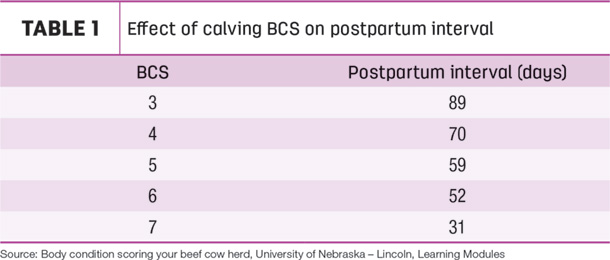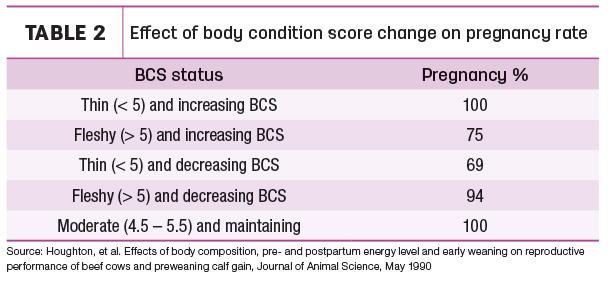The goal should be for each cow in the herd to produce a calf every 365 days, this means that more calves will be born earlier in the calving season, which leads to a heavier, more consistent calf crop and, ultimately, more dollars in your pocket.
After calving, cows experience a temporary period of infertility known as postpartum anestrus. During this time, the uterus returns to its non-pregnant size, shape and position so that it is able to support another pregnancy. The end of the anestrous period is usually marked by a first estrous cycle that is shorter in duration than usual cycles and characterized by decreased fertility. Since the gestation length of a cow is around 283 days, it only has 82 days to recover from giving birth and conceive again to maintain a yearly calving interval. This makes successfully managing the length of the postpartum anestrous period one of the most important things you can do for your bottom line.
Use body condition score to manage postpartum anestrous
The biggest single factor in how long it takes for a cow to return to cyclicity after calving – and the one you have the most control over – is nutrition, which is tied closely to body condition score (BCS). Cows that calve at a BCS 3 or 4, on average, exhibit first estrus at approximately 80 days post-calving, making it very difficult for you to maintain a one-year calving interval. On the other hand, females that calve at a BCS 5 or 6 average 55 days to first heat post-calving (Table 1).

What if cows are thinner at calving than you would like?
Managing for a moderate body condition prior to calving is the most efficient method to control the length of postpartum anestrous; however, the good news is that while BCS at calving can influence rebreeding performance, it doesn’t necessarily mean thin cows will always exhibit decreased reproductive performance. Research tells us that the direction and magnitude of bodyweight change after calving and through breeding play a large role. A thin cow that gains condition has an increased probability of becoming pregnant, meaning the effects of poor body condition (less than 4) can be overcome by improved nutrition (Table 2).

The quandary of it all is that during early postpartum a cow is experiencing some of the highest maintenance energy requirements of her life, which means additional supplementation will likely be needed. If you have the ability and pen space, the most economical strategy is to sort cows into management groups by BCS. This enables you to strategically provide additional nutrient resources to your thin cows while not overconditioning the fleshy cows.
The bottom line is that while it is more economical and easier to manage thin cows for increased body condition in mid-to-late gestation, if you find yourself with cows that are a little thinner than you would like at calving, it’s not too late to start managing for optimum body condition, which will help set you up for success come breeding season. ![]()
PHOTO: Body condition is the biggest factor that affects how long it will take a cow to return to cyclicity after calving. Photo by David Cooper.
-
Sarah Thorson
- U.S. Beef Marketing
- and Education Manager
- Genex
- Email Sarah Thorson








